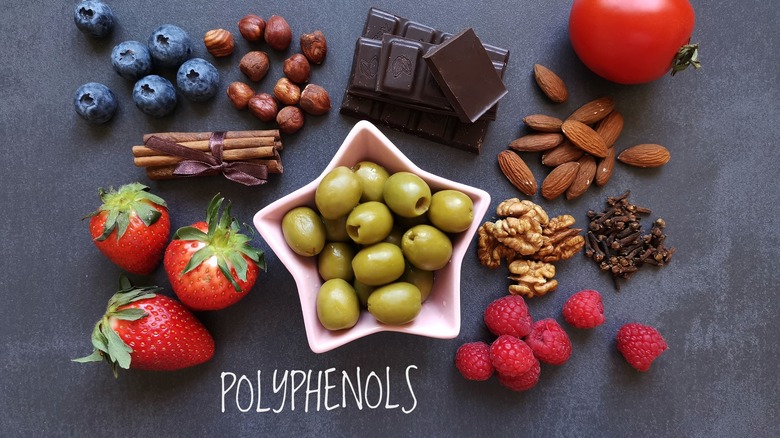How To Tell If Your Food Is Polyphenol-Rich In Three Seconds
Did you know there are over 8,000 different types of polyphenols (via WebMD)? The four main types are flavonoids, polyphenolic amides, phenolic acids, and various other polyphenols such as resveratrol which are found in red wine. Polyphenols are compounds found in plants that act to reduce inflammation because of their antioxidant properties, Healthline reports. Found in fruits, vegetables, whole grains, and more — here's exactly how to tell if your food is polyphenol-rich or not.
The easiest trick is to taste-test your food. Or, as gastroenterologist, Dr. Emeran Mayer, likes to call it, use your "own personal testing mechanism" (via MindBodyGreen). Take juicy, ripe raspberries, for instance. The flavor should be rich and sweet with a subtle tartness to it. If it does, rest assured this richness in flavor is associated with high levels of polyphenols. However, say you bite into the berry, but it tastes bland and not quite like a berry. Then "they probably have a low concentration of polyphenols," points out Mayer.
For optimal taste-testing, get all of your senses involved and savor your food. Focus on what it smells like, the intensity of flavor, and the aftertaste (per MindBodyGreen).
What are the foods highest in polyphenols?
After taste-testing your food for polyphenols, the next best option is to reach for foods naturally high in these compounds. While polyphenols are commonly found in plant-based foods, some contain higher concentrations. However, these levels can change depending on where the food was grown, how it was harvested, stored, or transported, and its ripeness (via MedicineNet).
Some of the foods highest in these micronutrients per serving are red wine, dark chocolate, berries, and tea (per MedicineNet). Berries, in particular, contain high amounts of vitamin C, in addition to being a low calorie food. According to WebMD, the most polyphenol-rich berries are chokeberries, which contain 1,123 milligrams of polyphenols for each half-cup serving. Next are elderberries (870 milligrams), blueberries (535 milligrams), blackcurrants (485 milligrams), and strawberries and raspberries (160 milligrams).
When it comes to vegetables, the highest foods with polyphenols are artichokes (260 milligrams), red onion (168 milligrams), and spinach (about 40 grams per cup). Keep in mind that most vegetables contain polyphenols. Aim to incorporate at least 2-3 cups of vegetables per day, as recommended by the Centers for Disease Control and Prevention. Other foods that are great sources are asparagus, broccoli, black beans, nuts, and various spices like cinnamon (via Healthline).


